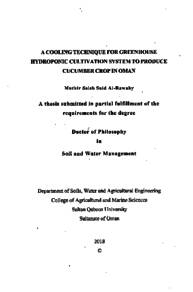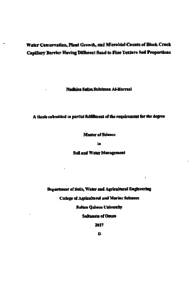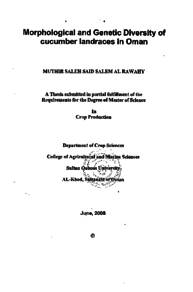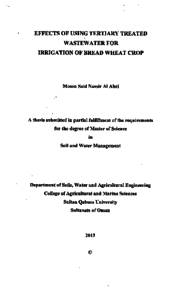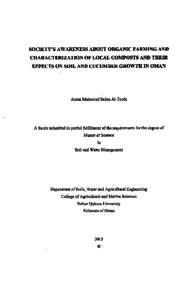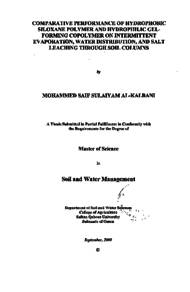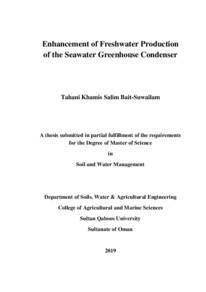Document
A cooling technique for greenhouse hydroponic cultivation system to produce cucumber crop in Oman
Publisher
Sultan Qaboos University
Gregorian
2018
Language
English
English abstract
During summer cropping seasons (May-September) in Oman embient air temperature normally exceeds 40°C as a result of which there is increase in nutrient solution temperatures in hydroponic systems leading to decreased crop production. This study was conducted to improve yield potential and quality of cucumber (Cucumis Sativa L.) through improving root zone temperature (RZT) to improve nutrient uptake, growth and development during three cropping periods, viz. Summer (June-August), Fall (September-November) and Spring (February-May) for two years- 2016/2017 and 2017/2018 in the greenhouse at Directorate General of Agriculture and Livestock Research at Rumais in the Wilayat Barka Oman. The plants were grown in perlite medium of root-zone cooled temperatures of 22°CE1, 25°C+1, 28°C+1 treatments respectively besides the control (33°C+2). The results indicated that the crop at root-zone temperatures of 22°C+1 and 25°C+1 showed superior performance in terms of plant height, leaf number/plant, chlorophyll content, leaf area , fruit number/m2, yield, fresh and dry weight (g) shoot and root with significant differences between the treatments in all three cropping periods. Higher fruit yield was produced with cooled RZT-22°C+and cooled RZT-25°CE1 (4.4-8.7 ton/gh) as compared to the uncooled RZT-33°C+1 (2.8-6.5 ton/gh) during all three cropping periods in both the years. The plants at cooled RZTs responded positively and significantly (p<0.05) in the uptake of all nutrient elements in leaves, fruits, shoots and roots in comparison with uncooled RZT in all cropping periods in both years. Quality attributes like fruit length, diameter and total soluble solid percentages did not show any significant differences between the treatments in all cropping periods. Further, cooling of nutrient solution temperature was found influencing positively the levels of dissolved oxygen in the fresh and drained nutrient solutions in all cropping periods. Significant (p<0.05) differences between the treatments were observed in oxygen consumption by the plants (roots) of cucumber in all cropping periods. High levels of oxygen consumption were recorded with plants of cooled RZTs in all the cropping periods. All growth and production and quality attributes were positively influenced and greatly expressed by cooled root-zone temperature under the root-zone of cucumber with increased dissolved oxygen levels in nutrient solution. Regarding Cost Benefit Analysis the results indicate that all the four cooling nutrient temperature yields positive returns (benefits) above variable and total costs for the two years of this experiment. Cooling nutrient temperature (22°C+1) yields higher returns than the other treatments followed by treatment (25°C+1), (28°C+1) compaed to control (33°C+2). This study found that cooling of root-zone temperature that facilitates availability of optimum aeration (oxygen levels) in nutrient solution is essential and could be of significance for boosting cucumber yield as observed during high temperature growing periods in summer (May-September) in Oman.
Member of
Resource URL
Arabic abstract
تقنية التبريد لنظام الزراعة المائية في البيوت المحمية لإنتاج محصول الخيار في عمان خلال موسم الصيف (مايو- سبتمبر) في عمان تتعدى دراجات الحرارة 40 درجة مئوية ونتيجة ذلك تؤدى الى ارتفاع درجة حرارة المحلول المغذي في خزان التغذية لنظام الزراعة المائية (النظام المغلق) مما يؤدي بدوره الى موت النباتات وقلة الإنتاجية للمحصول. لذا كان الهدف الرئيس من هذه الدراسة هو تحسين الإنتاجية وجودة محصول الخيار من خلال تحسين درجة حرارة منطقة الجذور من أجل تحسين إمتصاص العناصر الغذائية والنمو والتطور النباتات الخيار خلال ثلاث فترات الزراعية للمحصول في عمان وهي فترة الصيف (يونيو أغسطس)، فترة الخريف (سبتمبر-نوفمبر) وفترة الربيع (فبراير- مايو) لمدة عامين 17 / 2016 و 2018 / 2017 على التوالي في البيت المحمي (270م2) في المديرية العامة للبحوث الزراعية والحيوانية في الرميس بولاية بركاء. وكانت النباتات مزروعة في وسط زراعي البرلايت في ثلاثة معاملات درجات التبريد في منطقة جذور النباتات إلى جانب الشاهد وهي 22درجة مئوية، 25 درجة مئوية و 28 درجة مئوية والشاهد الغير مبرد 33 درجة مئوية. أشارت النتائج أنه عند درجات الحرارة 22 درجة مئوية و 25 درجة مئوية لمنطقة الجذور أدى الى التفوق في الأداء بالنسبة للمحصول من حيث إرتفاع طول النبات، عدد الأوراق للنبات، محتوی الكلوروفيل، مساحة الورقة للمتر المربع، عدد الثمار للمتر المربع، الإنتاجية طن البيت، الوزن الرطب والجاف النباتات مع وجود فروقات معنوية عالية بين المعاملات لجميع الفترات الزراعية الثلاث . أعلى الأنتاجية كانت عند درجات الحرارة 22 و 25 درجة مئوية لمنطقة الجذور حيث تراوحت مابين 8 . 7 . 4 . 4 طن للبيت المحمي بالمقارنة مع الشاهد 33 درجة مئوية (الغير مبرد) حيث أعطى أقل انتاجية ترواحت مابين 2 . 8-6 . 5 طن للبيت الثلاث فترات زراعية لمدة سنتين. استجابت النباتات المنطقة الجذور المبردة إيجابيا ومعنويا في إمتصاص جميع العناصر الغذائية في كل من الأوراق، الثمار، السيقان والجذور مقارنة مع الشاهد لثلاث فترات زراعية . لم تظهر سمات الجودة مثل طول الثمار، قطر الثمار و نسبة المواد الصلبة الذائبة الكلية أي فروقات معنوية إحصائية بين جميع المعاملات لجميع فترات الزراعة الثلاث . علاوة على ذلك فإن تبريد المحلول المغذي أعطى تأثيرا إيجابيا لمستوى الأكسجين الذائب في المحلول المغذي الأصل والمحلول المغذي الراجع الصرف) لجميع فترات الزراعة الثلاث وقد لوحظ وجود فروقات معنوية عالية بين المعاملات في إستهلاك الأكسجين من قبل جذور نباتات الخيار في جميع فترات الزراعة الثلاث. تم تسجيل أعلى مستويات إستهلاك الأكسجين الذائب في النباتات ذات درجات الحرارة الأقل لمحلول المغذي في منطقة جذور (22، 25 و28 درجة مئوية) مقارنة مع الشاهد لجميع فترات الزراعة خلال سنتين. جميع خصائص النمو والإنتاج والجودة تأثرت إيجابيا وبدرجة كبيرة مع درجات حرارة المحلول المغذي في منطقة الجذور لمحصول الخيار مع زيادة مستوى الأكسجين الذائب في المحلول المغذي. لذا تشير نتائج هذه الدراسة إلى أن تبريد درجة حرارة منطقة الجذر التي توفر التهوية المثلى (مستويات الأكسجين في المحلول المغذي تسهم بشكل فعال في رفع انتاجية محصول الخيار خلال فترات درجات الحرارة المرتفعة في الصيف (يونيوسبتمبر) في عمان.
Category
Theses and Dissertations

